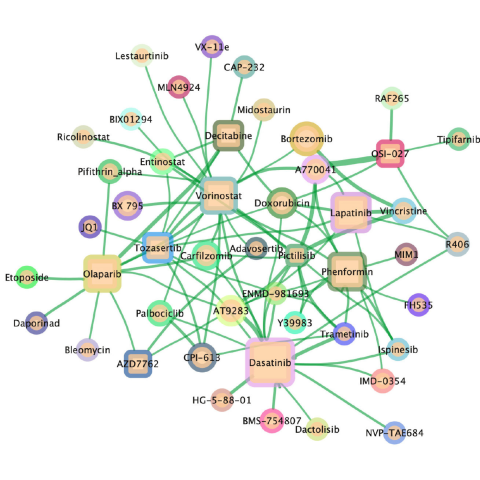
CCR researchers created a large library that linked thousands of drug combinations that work synergistically to treat lung cancer. Seen in this graphic is a network view of some of the drug combinations that were discovered to be effective. Image credit: Ruppin lab
Researchers have created a new, massive data resource that points to numerous specific drug combinations, as well as general insights into drug synergy, that could be particularly effective for treating lung cancer. The results appeared June 28, 2023, in Nature Communications.
While many anti-cancer drugs exist, cancers can become resistant to some drugs over time. “Drug combinations are often seen as important tools to delay resistance and enable better efficacy against cancer than a single drug,” explained Nishanth Ulhas Nair, Ph.D., a Staff Scientist in the lab of Eytan Ruppin, M.D., Ph.D., Chief of the Cancer Data Science Laboratory.
To gain more insights into which drug combinations might be effective for treating non-small cell lung cancer (NSCLC), the most common form of lung cancer, Nair and his colleagues, in partnership with researchers at the lab of Cyril Benes, Ph.D., at Harvard University, Cambridge, MA, undertook the daunting task of testing more than 5,000 drug combinations across 81 cancer cell lines of NSCLC grown in the lab. The goal was to find drug combinations that are synergistic, meaning the drugs are markedly more effective against cancer when combined, compared to their individual efficacy.
The results showed that, although synergy between drugs is rare overall, there are some combinations that could lead to more effective treatment of lung cancer. For example, a combination of CHK1 inhibitors and WEE1 inhibitors was particularly effective across many cell lines tested in this study. WEE1 inhibition can suppress tumor cell proliferation and sensitize cells to the effects of DNA-damaging agents, while CHK1 inhibitors work by preventing damaged cells from continuing through their cell cycle as they divide and replicate. This discovery suggests that many lung cancer patients could potentially benefit from this dual therapy.
Other drugs that were found to be particularly synergistic with a second drug include Poly-ADP-Ribose-Polymerases (PARPs), which interfere with the repair of double-stranded DNA breaks. These drugs were found to be synergistic with decitabine and zebularine, which are known to induce demethylation of DNA. MEK inhibitors and drugs targeting the PI3K pathway also appear to be good candidates to combine with other drugs.
The analysis by Nair and his colleagues also revealed important insights into what makes a drug synergistic in the context of lung cancer. In general, drugs that target multiple pathways tend to be more likely to be synergistic with other drugs. Additionally, two drugs that target a shared pathway or that target similar protein-protein interactions tend to be more synergistic together than drugs that do not.
Notably, the NCI researchers partnered with researchers led by Craig Thomas, Ph.D., at the National Center for Advancing Translational Sciences (NCATS) to help validate the top most promising combinations in an additional screen, and additional work was done to cross-reference this new dataset with genomic and transcriptomic data from humans using the Cancer Genome Atlas (TCGA). “As a result, this dataset is a great resource for other researchers to explore,” said Nair, noting that it lays the groundwork for researchers to begin testing these newly identified drug combinations in animal models. “It’s a huge data source — possibly the largest of its kind — and that, together with the insights gained from its analysis, are the key contributions of this work.”